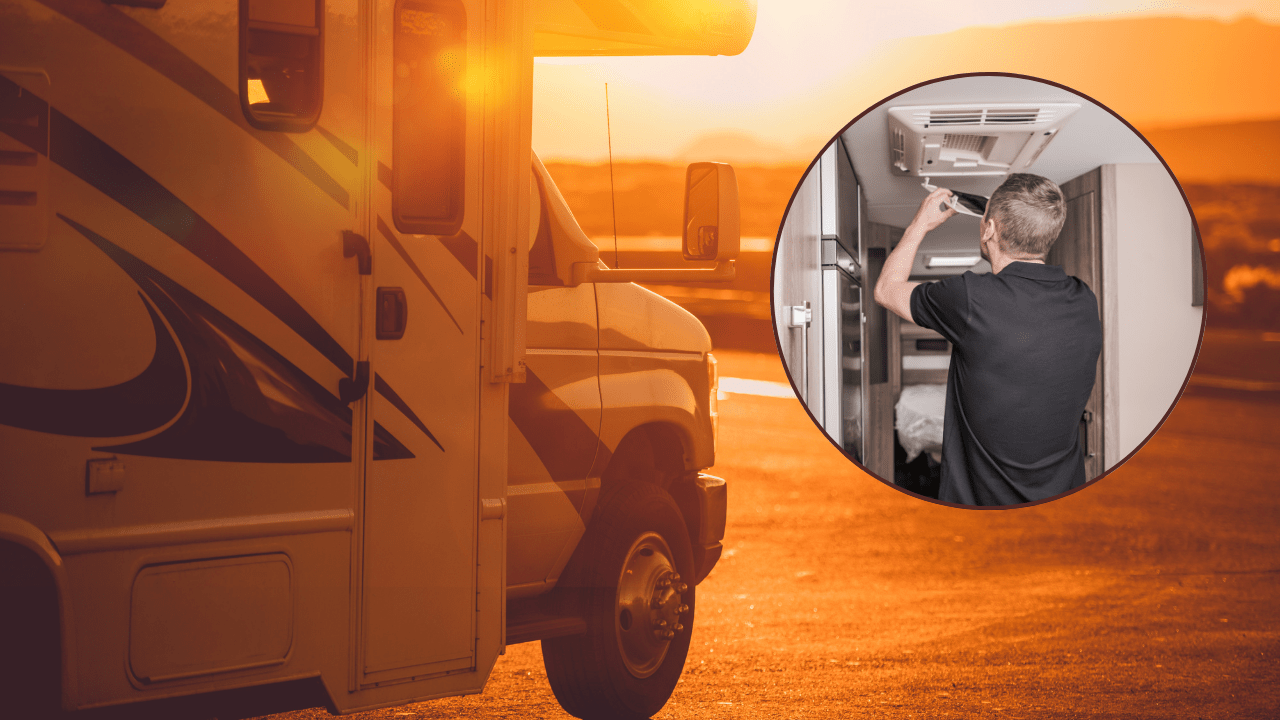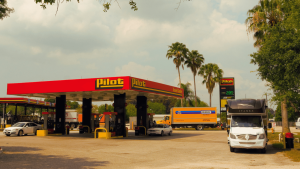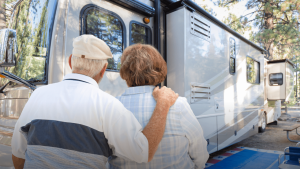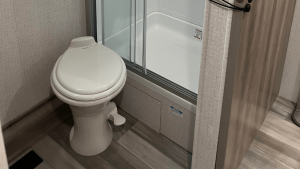Camper FAQs is reader-supported. Buying through links on our site may earn us an affiliate commission. As an Amazon Associate I earn from qualifying purchases.
When summer heat hits hard, your rig can turn into an oven fast. ACs work overtime, fridges struggle to keep up, and sleep? Forget it.
But you can take back control and keep your cool, without packing up and heading home.
Here are 7 smart ways to beat the heat and enjoy RV life, even when the temps are pushing triple digits.
1. Park in the Shade and Use Your Awning
Whenever possible, park your RV so it’s shaded during the hottest part of the day. Large trees or buildings, for example, can help reduce the direct sunlight hitting your rig.
If natural shade isn’t available, pull out your RV awning to block the sun on the entry side. It won’t cover the whole vehicle, but it does help cool the shaded side and gives you a place to sit outside without overheating.
You can also use a ShadeRV canopy from ShadeRV.com. It’s a lightweight, HDPE fabric canopy designed to cover your entire roof, blocking about 95% of UV rays and effectively reducing roof surface heat. It’s not cheap and does require manual setup every time you camp in the heat. Of course, this isn’t an option if you have solar panels on your roof. I’d also want to make sure there’s good airflow for your rooftop AC.
2. Cover Your Windows
Windows are a major source of heat gain in an RV. Large ones especially let in a lot of radiant heat. Covering them is one of the most effective ways to slow down the heat coming in.
Use reflective materials like Reflectix on the inside of your windshield and larger windows. Side windows do well with thermal curtains or blackout shades. For a quick solution, even sunshades or heavy blankets can help keep sunlight out.
3. Cool the Roof
The roof takes direct sun exposure for most of the day and gets extremely hot. That heat transfers inside and keeps your RV warmer than the outside air, even after the sun sets.
One long-term solution is applying a white or reflective roof coating that helps reflect sunlight and reduces heat absorption. A well-known option is Henry Tropi-Cool 100% Silicone Roof Coating. It’s white, UV-resistant, and designed specifically for RVs and mobile homes. It also stays flexible, resists cracking, and can handle ponding water.
In hot, dry climates, temporarily spraying the roof with water may bring down the surface temperature, though this only provides short-term relief and only works where water isn’t restricted.
4. Ventilate During Cooler Hours
This works best if the outside temperature drops at night or early in the morning. The basic idea is to remove hot air from inside and replace it with cooler air from outside.
Here’s how it works:
- Hot air rises. During the day, the inside of your RV heats up, and that hot air rises to the ceiling.
- If you run a roof vent fan in exhaust mode, it pulls that trapped hot air out from the top of your RV.
- In the early morning or late evening, the outside air is usually cooler than the air trapped inside your RV. So by opening lower windows or vents and using the roof fan, you can create a flow that replaces the hot air with cooler outside air.
This method doesn’t cool the RV in the middle of the day when outside temps are hotter than inside. But if used correctly (especially overnight and early morning), it can lower your RV’s starting temperature for the day and make a big difference by reducing heat buildup.
If you’re in a place where nighttime temperatures don’t drop much, this won’t help much either. But in many places, especially in deserts or dry climates, it can be very effective.
5. Add Insulation Where You Can
Most RVs don’t have the same level of insulation as a house, but there are some small steps that help.
Add foam board insulation to the inside of cabinet doors, storage bays, and behind drawers. Cover roof vents and skylights with insulated cushions or covers. Even small gaps around doors or windows can be sealed with weather stripping to reduce heat entry.
6. Limit Cooking Inside
Stoves, ovens, and even some appliances can add noticeable heat inside a small space. During the hottest part of the day, try to avoid cooking indoors.
Use an outdoor grill, camp stove, or electric griddle under your awning. Cold meals like sandwiches, salads, or wraps can also help cut down on indoor heat without sacrificing convenience.
7. Use Air Conditioning Wisely
If you have shore power or a generator, air conditioning is a big help, but it works better when paired with other strategies.
Remember to clean your AC filters regularly so airflow isn’t restricted. Use fans to help circulate the cool air. If you’re in a larger rig, consider closing off unused sections with a curtain or door to focus cooling in the main living area. And consider a secondary portable AC unit if your rooftop model struggles to keep up.
Let us know what tips you have to keep an RV cool in the comments below!







Write a comment